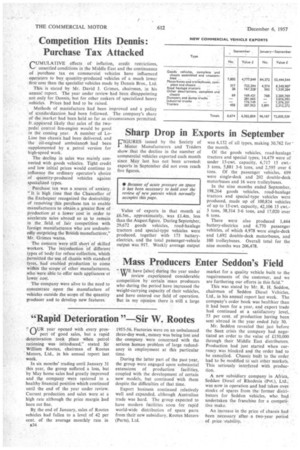Competition Hits Dennis: Purchase Tax Attacked
Page 84

If you've noticed an error in this article please click here to report it so we can fix it.
CUMULATWE effects of inflation, credit restrictions, unsettled conditions in the Middle East and the continuance of purchase tax on commercial vehicles have influenced operators to buy. quantity-produced vehicles of a much lower first cost than the specialist vehicles made by Dennis Bros., Ltd. This is stated by Mr. David J. Grimes, chairman, in his annual report. The year under review had been disappointing
not only for Dennis, but for other makers of specialized heavy .vehicles. Prices had had to be raised.
Methods of manufacture had been improved and a policy of standardization had been followed. The company's share of the market had been held so far as circumstances permitted.
It appeared likely that sales of the twopedal control fire-engine would be good in the coming year. A number •of LoLine bus chassis had been delivered, and the oil-engined ambulance* had been supplemented by a petrol version for high-speed work.
The decline in sales was mainly connected with goods vehicles. Tight credit and low initial prices would continue to influence the ordinary operator's choice of quantity-produced vehicles against specialized types.
Purchase tax was a source of anxiety. " It is high time that the Chancellor of the Exchequer recognized the desirability of removing this purchase tax to enable manufacturers to obtain kgreater flow of Production at a lower cost in order to• accelerate sales abroad so as to remain in the field, of fair competition with foreign manufacturers who are undoubtedly outpricing the British manufacturer," Mr. Grimes warns.
The concern were still short of skilled workers. The introduction of different types of body for refuse collection, which Permitted the use of chassis with standard tyres, had enabled production to come within the scope of other manufacturers, who were able to offer such appliances at lower cost.
The company were alive to the need to concentrate upon the manufacture of vehicles outside the scope of the quantity producer and to develop new features.
























































































































